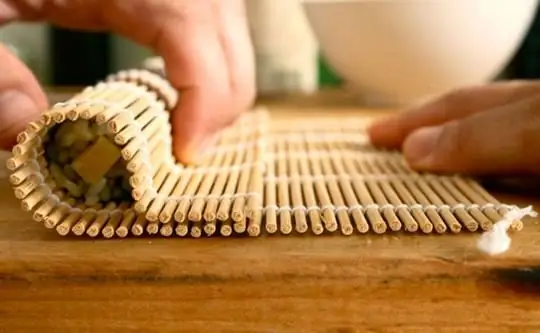2025 Author: Isabella Gilson | [email protected]. Last modified: 2025-01-23 12:50:33
Makisushi, rolls, maki are subspecies of a dish in Japanese cuisine that differ in cooking technology - the ingredients are combined using bamboo mats (makisu) by twisting. Subsequently, the product is cut into pieces (as usual, into six to eight identical pieces) and served on the table in portions. Today, the Japanese curiosity is quite popular in the post-Soviet open spaces, so we will tell you how to cook rolls at home. Nothing super complicated, but the savings are significant. In addition, store-bought sushi is often overdried (sorry for the tautology) and, frankly, not the first freshness. And constantly ordering them with delivery (well, if you are an ardent fan of Japanese cuisine) - you will not save up money. Therefore, one of the best options for non-professional cooks to treat themselves to their favorite exotic would be cooking rolls at home.

A little about twisting technologies
The dish is quite ancient, so the cooking method, although authentic, is, in general, simple. The fillings are wrapped in nori (pressed and dried seaweed). Less common are makisushi, pre-rolled in this way: a seaweed sheet is placed inside, the filling is outside. There are also "mosaic", as well as other types of this dish.
Roll categories
So, are you seriously thinking about how to make rolls at home? Then you need to know what we are actually going to cook. There are several modern varieties.
- Traditional, prepared according to the recipe of classic Japanese cuisine. They, as a rule, are a thin roll, and one component is used as fillings (salmon or crab, perch or eel). It is topped with prepared rice and wrapped tightly in nori sheets.
- Branded. Numerous Japanese restaurants develop their own special makisushi recipes, so to speak, from the chef. This is the most extensive category of recipes.
- "California". By the way, you will not find this dish in Japan (invented in the USA). Mandatory components for the filling: avocado, crab meat, and the outside of the rolls is sprinkled with caviar (tobiko). This dish is also prepared with a cucumber (fresh, not s alted) instead of an avocado fruit, with mayonnaise, with salmon fillet or tuna, with shrimp meat.
- Philadelphia. Also absent from the Japanese islands, except perhaps in American restaurants. This is one of the most popular varieties of "inverted" rolls (rice up). The filling is flavored with soft Philadelphia cheese, greens with cucumber, and eggs with avocado fruit can be added. Outside such poppy-the sushi is wrapped with rather thin slices of salmon fillet.
- There are also varieties that differ in that their heat treatment is carried out in deep fat.

Main ingredients
To cook rolls at home, you will need special rice, pressed seaweed, various stuffing ingredients. They are rolled in nori, then cut into bite-sized pieces. They are meant to be eaten in one fell swoop and are often dipped in soy sauce. Wasabi (Japanese spicy horseradish) and pickled ginger are also used. Makizushi is perfect for appetizers at parties or in a restaurant. In Japan, they are often prepared for the holidays. Versions of makisushi with vegetable or pickled fillings can also be included in a classic Japanese lunch. And canned tuna, vegetables and even eggs can also be used as fillers.

Rice wisdom
Rice for rolls at home is one of the most important elements. It is recommended to use only the special one because it is more sticky than the other and will not fall apart. Sushi rice can be made at home with just a few ingredients. Many stores also offer pre-made dry mixes in bags. You'll also find bottled and aged sushi vinegar at markets that typically stock Japanese food.
The first roll is lumpy
And when you already have the "correct" rice, you need to learn rolling skillsrolls at home. The bamboo sushi mat is a very important tool that makes this process so much easier. It also needs to be purchased - it is quite inexpensive, if you take the usual, everyday option. Twisting looks relatively easy, but it does take some practice to get it to work properly. Don't worry about making any mistakes: your misses will still be there, and maca sushi may just crumple or fall apart. It will be useful for you, for example, to watch a few videos to see the technique in action. And remember: the first pancake (in our case, a roll) is always lumpy!
Rolls at home. Step by step recipe
The specificity of the dish is mainly in the way it is prepared. How to make rolls at home? You can see a photo illustrating the process of creating a homemade sushi roll just below. Key Points: Maki sushi should only contain rice and toppings. Nori should not be twisted in a spiral inside the sushi roll being made. To ensure this, when you place the rice on top of the seaweed, don't pile it right down the middle. Well, shall we begin?
1. Place the nori sheet on the bamboo mat with room to spare. The free edge will be further away from you.
2. Spread the rice over the nori. Leave about 5 millimeters of space between the rice and the seaweed at the edge closest to you. The other side needs a margin, much more: about 3 centimeters from the edge. Lay the rice in a layer about 5 millimeters thick. Align it so that the grains at the ends are slightly thicker than inmiddle.

3. Cut out thin strips of filling and line them up in the middle (not the center of the nori). Fillers should take up no more than one-third of the rice.

4. Take the end of the rug that is closest to you and start rolling it away from you. When the rug is ready to be rolled up, pull the edge and straighten it to the far end. You can then use thin strips of bamboo to complete the rolls. And at home, as you can see, it is quite possible to cook such a yummy..

5. Gently but firmly squeeze the maca sushi inside the mat as you work on the dish. By the time you reach your goal, you should have a well-shaped and packaged sushi roll.

6. Typically, maki sushi is cut into six to eight equal pieces.

Homemade
To prepare the rolls, we need: one and a half cups of rice, sheets of nori seaweed - eight pieces, a pound of filet or minced lightly s alted salmon, fresh cucumber, rice vinegar, pickled ginger, soy sauce, s alt with sugar - to individual taste.
How to cook
To make the rolls at home “correct”, we take a bamboo rug. Let's try to cook thin. This is the simplest version of the dish.

- How to make rolls at home? Place the nori sheet on the mat with the shiny side down. Rough should stay on top.
- Wet hands a little with water, to which we add vinegar.
- We take four tablespoons of cooked rice (possible with a slide), distribute it over the surface of the sheet and leave a free strip in the upper edge. At the bottom, we also retreat a little from the edges of the rug.
- Do not forget to wet your hands to distribute the rice evenly over the plane. The height of the rice layer will be 5-7 millimeters.
- Place the stuffing on top. In this case, fish with cucumber and pickled ginger. But you can use other options as well. In general, don't be afraid to experiment.
- Start rolling the roll gradually, slowly. And so that it doesn’t tear or crumple, we constantly crimp the mat.
- Cutting maki sushi is also an important thing. Do not allow rice or filling to fall out of them. How to prepare everything in the perfect way? Just dip your knife into the water with vinegar added. Thanks to this simple method, the knife will slip through the filling and rice. By the way, Japanese sushi masters recommend cutting the roll in the center, then additionally each piece into 3 more pieces. Let's hope everything works out for you!
Recommended:
How to cook rolls at home: a step by step recipe

Japanese cuisine in today's globalized world is gaining more and more popularity. And for some reason, it so happened that it was sushi, an appetizer of rice and fish or seafood, that Europeans liked more than other delights of the culinary art of the Land of the Rising Sun. Going to Japanese restaurants every day is expensive, and probably many people have thought about how to cook sushi (rolls) at home
Why are rolls so expensive? We consider the cost of rolls and their ingredients

Rolls are very popular today all over the world. Alas, ordering them in restaurants or sushi bars is a very expensive pleasure. Therefore, many connoisseurs prefer to cook them at home. Is it justified? Let's look into this issue
How to cook rolls at home: a step by step recipe with a photo

Detailed instructions on how to cook rolls at home. Step-by-step description of the process, features of choosing the necessary products, as well as many useful tips
Sushi recipe at home. Cooking rolls at home

This article provides detailed instructions on how to use the sushi recipe at home. Tips are given on how to get by with simple, affordable products and surprise friends and loved ones with delicious Japanese cuisine
Home breweries: reviews. Home mini-brewery. Home Brewery: Recipes

What makes homebreweries so good? Reviews of those who have already used these machines for making beer, various important nuances and advantages of such an acquisition - all this can be read in the text below

